Bio-medical waste and its segregation
Bio-medical waste and its segregation
All human activities produce waste. We all know that such waste may be dangerous and needs safe disposal. Industrial waste, sewage and agricultural waste pollute water, soil and air. It can also be dangerous to human beings and environment. Similarly, hospitals and other health care facilities generate lots of waste which can transmit infections, particularly HIV, Hepatitis B & C and Tetanus, to the people who handle it or come in contact with it.
India generates around three million tonnes of medical wastes every year and the amount is expected to grow at eight per cent annually.
MoEF&CC and UNIDO Video on Safe Waste Management Practices for COVID-19 at Hospitals as per CPCB guidelines
Types of Bio-medical waste
Bio-medical waste means “any solid and/or liquid waste including its container and any intermediate product, which is generated during the diagnosis, treatment or immunization of human beings or animals or research activities pertaining thereto or in the production or testing of biological or in health camps.
Biomedical waste poses hazard due to two principal reasons – the first is infectivity and other toxicity.
Bio Medical waste consists of
- Human anatomical waste like tissues, organs and body parts
- Animal wastes generated during research from veterinary hospitals
- Microbiology and biotechnology wastes
- Waste sharps like hypodermic needles, syringes, scalpels and broken glass
- Discarded medicines and cytotoxic drugs
- Soiled waste such as dressing, bandages, plaster casts, material contaminated with blood, tubes and catheters
- Liquid waste from any of the infected areas
- Incineration ash and other chemical wastes
The biomedical waste (BMW) management requires its categorisation as a first step. The BMW Rules classify the BMW into following categories.
|
CATEGORIES OF BIOMEDICAL WASTE SCHEDULE – I |
|||
|
CATEGORY |
TYPE OF WASTE |
TYPE OF BAG OR CONTAINER TO BE USED |
TREATMENT AND DISPOSAL OPTION |
|
Yellow
|
Human tissues, organs, body parts and fetus below the viability period (as per the Medical Termination of Pregnancy Act 1971, amended from time to time). |
Yellow coloured non-chlorinated plastic bags
|
Incineration or Plasma Pyrolysis or deep burial * |
|
Animal Anatomical Waste : Experimental animal carcasses, body parts, organs, tissues, including the waste generated from animals used in experiments or testing in veterinary hospitals or colleges or animal houses. |
|||
|
Soiled Waste: Items contaminated with blood, body fluids like dressings, plaster casts, cotton swabs and bags containing residual or discarded blood and blood components. |
Incineration or Plasma Pyrolysis or deep burial * In absence of above facilities, autoclaving or micro-waving/ hydroclaving followed by shredding or mutilation or combination of sterilization and shredding. Treated waste to be sent for energy recovery. |
||
| Expired or Discarded Medicines: Pharmaceutical waste like antibiotics, cytotoxic drugs including all items contaminated with cytotoxic drugs along with glass or plastic ampoules, vials etc. |
Yellow coloured non-chlorinated plastic bags or containers
|
Expired cytotoxic drugs and items contaminated with cytotoxic drugs to be returned back to the manufacturer or supplier for incineration at temperature >1200 0 C or to common bio - medical waste treatment facility or hazardous waste treatment, storage and disposal facility for incineration at >1200 0 C Or Encapsulation or Plasma Pyrolysis at >1200 0 C All other discarded medicines shall be either sent back to manufacturer or disposed by incineration. |
|
| Chemical Waste: Chemicals used in production of biological and used or discarded disinfectants. |
Yellow coloured containers or non-chlorinated plastic bags
|
Disposed of by incineration or Plasma Pyrolysis or Encapsulation in hazardous waste treatment, storage and disposal facility . | |
| Chemical Liquid Waste : Liquid waste generated due to use of chemicals in production of biological and used or discarded disinfectants, Silver X - ray film developing liquid, discarded Formalin, infected secretions, aspirated body fluids , liquid from laboratories an d floor washings, cleaning, house - keeping and disinfecting activities etc. |
Separate collection system leading to effluent treatment system
|
After resource recovery, the chemical liquid waste shall be pre - treated before mixing with other wastewater. The combined discharge shall conform to the discharge norms given in Schedule - III. | |
| Discarded linen, mattresses, beddings contaminated with blood or body fluid. |
Non-chlorinated yellow plastic bags or suitable packing material
|
Non - chlorinated chemical disinfection followed by incineration or Plazma Pyrolysis or for energy recovery. In absence of above facilities, shredding or mutilation or combination of sterilization and shredding. Treated waste to be sent for energy recovery or incineration or Plazma Pyrolysis . | |
| Microbiology, Biotechnology and other clinical laboratory waste: Blood bags, Laboratory cultures, stocks or specimens of micro - organisms, live or attenuated vaccines, human and animal cell cultures used in research, industrial laboratories, production of biological, residual toxins, dishes and devices used for cultures. |
Autoclave safe plastic bags or containers
|
Pre - treat to sterilize with non - chlorinated chemicals on - site as per National AIDS Control Organisation or World Health Organisation guidelines thereafter for Incineration. | |
|
Red |
Contaminated Waste (Recyclable) Wastes generated from disposable items such as tubing, bottles, intravenous tubes and sets, catheters, urine bags, syringes (without needles and fixed needle syringes ) and vaccutainers with their needles cut) and gloves. |
Red coloured non-chlorinated plastic bags or containers
|
Autoclaving or micro - waving/ hydroclaving followed by shredding or mutilation or combination of sterilization and shredding. Treated waste to be sent to registered or authorized recyclers or for energy recovery or plastics to diesel or fuel oil or for road making, whichever is possible. Plastic waste should not be sent to landfill sites. |
| White (Translucent) |
Waste sharps including Metals: Needles, syringes with fixed needles, needles from needle tip cutter or burner, scalpels, blades, or any other contaminated sharp object that may cause puncture and cuts. This includes both used, discarded and contaminated metal sharps |
Puncture proof, Leak proof, tamper proof containers
|
Autoclaving or Dry Heat Sterilization followed by shredding or mutilation or encapsulation in metal container or cement concrete; combination of shredding cum autoclaving; and sent for final disposal to iron foundries (having consent to operate from the State Pollution Control Board s or Pollution Control Committee s) or sanitary landfill or designated concrete waste sharp pit. |
| Blue | Glassware: Broken or discarded and contaminated glass including medicine vials and ampoules except those contaminated with cytotoxic wastes |
Cardboard boxes with blue colored marking
|
Disinfection (by soaking the washed glass waste after cleaning with detergent and Sodium Hypochlorite treatment) or through autoclaving or microwaving or hydroclaving and then sent for recycling. |
| Metallic Body Implants | |||
* Disposal by deep burial is permitted only in rural or remote areas where there is no access to common bio - medical waste treatment facility. This will be carried out with prior approval from the prescribed authority and as per the Standards specified in Schedule - III. The deep burial facility shall be located as per the provisions and guidelines issued by Central Pollution Control Board from time to time.
Segregation
Segregation refers to the basic separation of different categories of waste generated at source and thereby reducing the risks as well as cost of handling and disposal. Segregation is the most crucial step in bio-medical waste management. Effective segregation alone can ensure effective biomedical waste management.
<>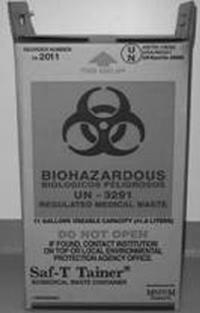 </p
</p
How does segregation help?
- Segregation reduces the amount of waste needs special handling and treatment
- Effective segregation process prevents the mixture of medical waste like sharps with the general municipal waste.
- Prevents illegally reuse of certain components of medical waste like used syringes, needles and other plastics.
- Provides an opportunity for recycling certain components of medical waste like plastics after proper and thorough disinfection.
- Recycled plastic material can be used for non-food grade applications.
- Of the general waste, the biodegradable waste can be composted within the hospital premises and can be used for gardening purposes.
- Recycling is a good environmental practice, which can also double as a revenue generating activity.
- Reduces the cost of treatment and disposal (80 per cent of a hospital’s waste is general waste, which does not require special treatment, provided it is not contaminated with other infectious waste)
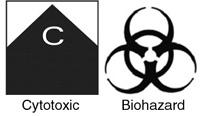
Proper labelling of bins
The bins and bags should carry the biohazard symbol indicating the nature of waste to the patients and public.
Collection
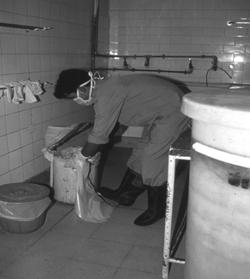 The collection of biomedical waste involves use of different types of container from various sources of biomedical wastes like Operation Theatre, laboratory, wards, kitchen, corridor etc. The containers/ bins should be placed in such a way that 100 % collection is achieved. Sharps must always be kept in puncture-proof containers to avoid injuries and infection to the workers handling them.
The collection of biomedical waste involves use of different types of container from various sources of biomedical wastes like Operation Theatre, laboratory, wards, kitchen, corridor etc. The containers/ bins should be placed in such a way that 100 % collection is achieved. Sharps must always be kept in puncture-proof containers to avoid injuries and infection to the workers handling them.
Storage
Once collection occurs then biomedical waste is stored in a proper place. Segregated wastes of different categories need to be collected in identifiable containers. The duration of storage should not exceed for 8-10 hrs in big hospitals (more than 250 bedded) and 24 hrs in nursing homes. Each container may be clearly labelled to show the ward or room where it is kept. The reason for this labelling is that it may be necessary to trace the waste back to its source. Besides this, storage area should be marked with a caution sign.
Transportation
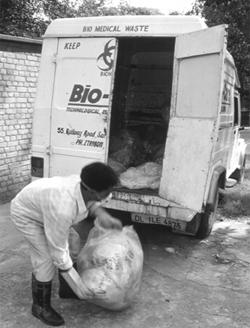 The waste should be transported for treatment either in trolleys or in covered wheelbarrow. Manual loading should be avoided as far as for as possible. The bags / Container containing BMWs should be tied/ lidded before transportation. Before transporting the bag containing BMWs, it should be accompanied with a signed document by Nurse/ Doctor mentioning date, shift, quantity and destination.
The waste should be transported for treatment either in trolleys or in covered wheelbarrow. Manual loading should be avoided as far as for as possible. The bags / Container containing BMWs should be tied/ lidded before transportation. Before transporting the bag containing BMWs, it should be accompanied with a signed document by Nurse/ Doctor mentioning date, shift, quantity and destination.
Special vehicles must be used so as to prevent access to, and direct contact with, the waste by the transportation operators, the scavengers and the public. The transport containers should be properly enclosed. The effects of traffic accidents should be considered in the design, and the driver must be trained in the procedures he must follow in case of an accidental spillage. It should also be possible to wash the interior of the containers thoroughly.
Personnel safety devices
The use of protective gears should be made mandatory for all the personnel handling waste.
Gloves: Heavy-duty rubber gloves should be used for waste handling by the waste retrievers. This should be bright yellow in colour. After handling the waste, the gloves should be washed twice. The gloves should be washed after every use with carbolic soap and a disinfectant. The size should fit the operator.
Aprons, gowns, suits or other apparels: Apparel is worn to prevent contamination of clothing and protect skin. It could be made of cloth or impermeable material such as plastic. People working in incinerator chambers should have gowns or suits made of non-inflammable material.
Masks: Various types of masks, goggles, and face shields are worn alone or in combination, to provide a protective barrier. It is mandatory for personnel working in the incinerator chamber to wear a mask covering both nose and mouth, preferably a gas mask with filters.
Boots: Leg coverings, boots or shoe-covers provide greater protection to the skin when splashes or large quantities of infected waste have to be handled. The boots should be rubber-soled and anti-skid type. They should cover the leg up to the ankle.
Cleaning devices
Brooms: The broom shall be a minimum of 1.2 m long, such that the worker need not stoop to sweep. The diameter of the broom should be convenient to handle. The brush of the broom shall be soft or hard depending on the type of flooring.
Dustpans: The dustpans should be used to collect the dust from the sweeping operations. They may be either of plastic or enamelled metal. They should be free of ribs and should have smooth contours, to prevent dust from sticking to the surface. They should be washed with disinfectants and dried before every use.
Mops: Mops with long handles must be used for swabbing the floor. They shall be of either the cloth or the rubber variety. The mop has to be replaced depending on the wear and tear. The mechanical-screw type of mop is convenient for squeezing out the water.
Vacuum cleaners: Domestic vacuum cleaners or industrial vacuum cleaners can be used depending on the size of the rooms.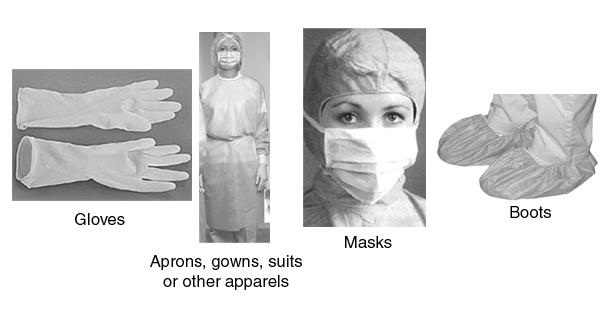
Storage devices
Dustbins:
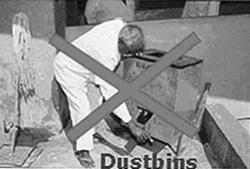 It is very important to assess the quantity of waste generated at each point. Dustbins should be of such capacity that they do not overflow between each cycle of waste collection. Dustbins should be cleaned after every cycle of clearance of waste with disinfectants. Dustbins can be lined with plastic bags, which are chlorine-free, and colour coded as per the law.
It is very important to assess the quantity of waste generated at each point. Dustbins should be of such capacity that they do not overflow between each cycle of waste collection. Dustbins should be cleaned after every cycle of clearance of waste with disinfectants. Dustbins can be lined with plastic bags, which are chlorine-free, and colour coded as per the law.
Handling devices
Trolleys
The use of trolleys will facilitate the removal of infectious waste at the source itself, instead of adding a new category of waste.
Wheelbarrows:
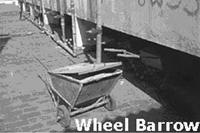 Wheelbarrows are used to transfer the waste from the point source to the collection centres. There are two types of wheelbarrow – covered and open. Wheelbarrows are made of steel and provided with two wheels and a handle. Care should be taken not to directly dump waste into it. Only packed waste (in plastic bags) should be carried. Care should also be taken not to allow liquid waste from spilling into the wheelbarrow, as it will corrode. These are ideal for transferring debris within the institution. Wheelbarrows also come in various sizes depending on the utility.
Wheelbarrows are used to transfer the waste from the point source to the collection centres. There are two types of wheelbarrow – covered and open. Wheelbarrows are made of steel and provided with two wheels and a handle. Care should be taken not to directly dump waste into it. Only packed waste (in plastic bags) should be carried. Care should also be taken not to allow liquid waste from spilling into the wheelbarrow, as it will corrode. These are ideal for transferring debris within the institution. Wheelbarrows also come in various sizes depending on the utility.
Chutes:
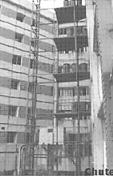 Chutes are vertical conduits provided for easy transportation of refuse vertically in case of institutions with more than two floors. Chutes should be fabricated from stainless steel. It should have a self-closing lid. These chutes should be fumigated everyday with formaldehyde vapours. The contaminated linen (contaminated with blood and or other body fluids) from each floor should be bundled in soiled linen or in plastic bags before ejecting into the chute.
Chutes are vertical conduits provided for easy transportation of refuse vertically in case of institutions with more than two floors. Chutes should be fabricated from stainless steel. It should have a self-closing lid. These chutes should be fumigated everyday with formaldehyde vapours. The contaminated linen (contaminated with blood and or other body fluids) from each floor should be bundled in soiled linen or in plastic bags before ejecting into the chute.
Alternately, elevators with mechanical winches or electrical winches can be provided to bring down waste containers from each floor. Chutes are necessary to avoid horizontal transport of waste thereby minimizing the routing of the waste within the premises and hence reducing the risk of secondary contamination.
Source : CPR Environmental Education Centre, Chennai
Related resources
Last Modified : 5/30/2023
CPCB guidelines on COVID-19 Waste Management
This topic covers the Information related to Handl...
